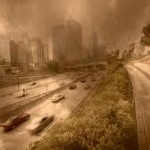 West Hollywood residents who want to see how the city’s air and groundwater compares with that of other communities have a resource in the California Environmental Protection Agency’s CalEnviro Screen.
West Hollywood residents who want to see how the city’s air and groundwater compares with that of other communities have a resource in the California Environmental Protection Agency’s CalEnviro Screen.
The website offers a map of California, broken down by ZIP zones, each of which has its traffic fumes, pesticides, diesel fumes, ozone and groundwater threats quantified.
West Hollywood’s 90069 ZIP zone, which is roughly bounded by Sweetzer Avenue on the east, Beverly Hills on the west, Melrose Avenue on the south and extends north of Sunset Boulevard, has an overall pollution burden score of 3.70. Scores range from 0.1 to 10. The other major ZIP zone in the city, 90046, has an overall score of 4.90. The 90046 zone that covers West Hollywood extends roughly from Sweetzer on the west, Melrose on the south, La Brea Avenue on the West and north of Sunset.
Cal/EPA has combined its measurement of pollution with an assessment of social and economic issues in various ZIP zones. “It is important to identify disadvantaged communities that face multiple pollution burdens so programs and funding can be targeted appropriately toward raising the economic and environmental status of the most affected,” it says in its report on the California Communities Environmental Health Screening Tool program.
The combined measurement results in a “CalEnviroScreen Score,” which ranges from 0.1 (the best) to 100 (the worst). The 90069 area has a score of 11.47. The 90046 area has a score of 16.66.
Major differences in the two areas are in pesticide particles, with 90069 ranking at zero and 90046 at 13.83; groundwater threats, with 90069 at 42.79 and 90046 at 89.98, and hazardous waste particles, with 90069 at 33.33 and 90046 at 66.53.

Rather big differences between the two zip code regions. Of course, the lower income side of town is more polluted.